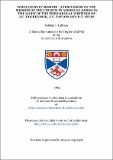Files in this item
Wholeness in mission : a discussion of the mission of the Church in American Samoa in the light of the theological writings of J.C. Hockendijk, J.V. Taylor and D.T. Niles
Item metadata
| dc.contributor.advisor | Mackie, Steven | |
| dc.contributor.author | Lafitaga, Falelua T. | |
| dc.coverage.spatial | ix, 129, 140-315 p. | en_US |
| dc.date.accessioned | 2018-05-29T10:28:05Z | |
| dc.date.available | 2018-05-29T10:28:05Z | |
| dc.date.issued | 1983-07 | |
| dc.identifier.uri | https://hdl.handle.net/10023/13583 | |
| dc.description.abstract | In a situation of social change, traditional structures of the Church no longer perform their original functions. A redefinition of the mission of the Church and a reformulation of its missionary strategy is necessary. The Church cannot, however, find what forms it should take simply through the analysis of modern society. The true answer can only come from an understanding of what God has done and is doing in and for the world and from a consideration of the unique commission and ministry of the universal Church. The theological writings of Hoekendijk, Taylor and Niles deal with these problems. Hoekendijk endorses the insoluble union of the church and mission. Mission, in his view, is the very essence of the church. The church, therefore, is the function of the apostolate at any place and in all situations. According to Taylor's analysis, the church cannot participate in mission without the power of the Creator Spirit. The Spirit is always central; he goes before the church; he creates in the church power and clarity; he makes the church become the missionary church. D.T. Niles relates these universal theological truths to the situation of a younger church. In particular, he discusses the mission of a younger church in terms of its self-hood in relation both to the church's mission in its own location and in the missionary enterprise. For Hoekendijk, Taylor and Niles, the church is not just a matter of private religion with no significance for emerging structures. Its task is not simply to propagate a particular religion as the 'home' for certain individuals, but to seek to address all dimensions of life. What is true for the church in general is also true for the life of a younger Church such as the Congregational Christian Church in American Samoa. On the basis of these theological insights we can say that the Church in American Samoa must always be the missionary Church in all times and in all situations. The Church should include all dimensions of modern society in defining its mission. The discussion of the new understanding of the mission of the Church and of missionary strategy does not imply fundamental change in the life of the Church. The missionary awareness of the Church must be re-awakened and stimulated in the light of such insights as those of Hoekendijk, of Taylor, and of Niles. In practical terms, this implies a rethinking of the mission of the Church in society and its involvement in the missionary movement. This ensures the participation of the whole Church, both ministers and laity. Finally, the structure and organization of the Church should correspond to the nature of the Church's existence in society and in the world. | en_US |
| dc.language.iso | en | en_US |
| dc.publisher | University of St Andrews | |
| dc.subject.lcc | BV2355.S2L2 | en |
| dc.subject.lcsh | Hoekendijk, Johannes Christiaan | en |
| dc.subject.lcsh | Taylor, John V. (John Vernon), 1914-2001 | en |
| dc.subject.lcsh | Niles, D. T. (Daniel Thambyrajah), 1908-1970 | en |
| dc.subject.lcsh | Christianity--Oceania | en |
| dc.title | Wholeness in mission : a discussion of the mission of the Church in American Samoa in the light of the theological writings of J.C. Hockendijk, J.V. Taylor and D.T. Niles | en_US |
| dc.type | Thesis | en_US |
| dc.type.qualificationlevel | Masters | en_US |
| dc.type.qualificationname | MPhil Master of Philosophy | en_US |
| dc.publisher.institution | The University of St Andrews | en_US |
This item appears in the following Collection(s)
Items in the St Andrews Research Repository are protected by copyright, with all rights reserved, unless otherwise indicated.

